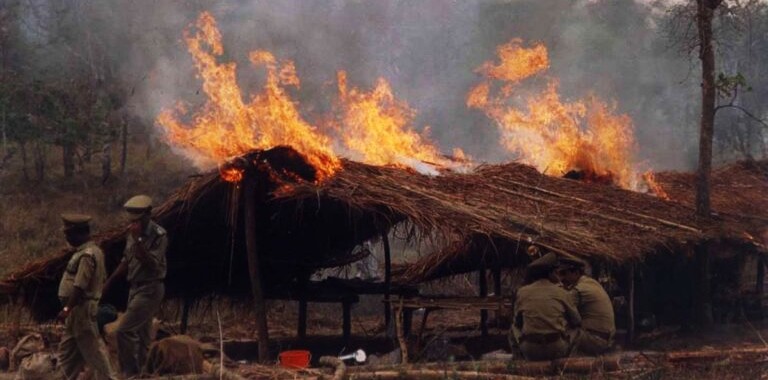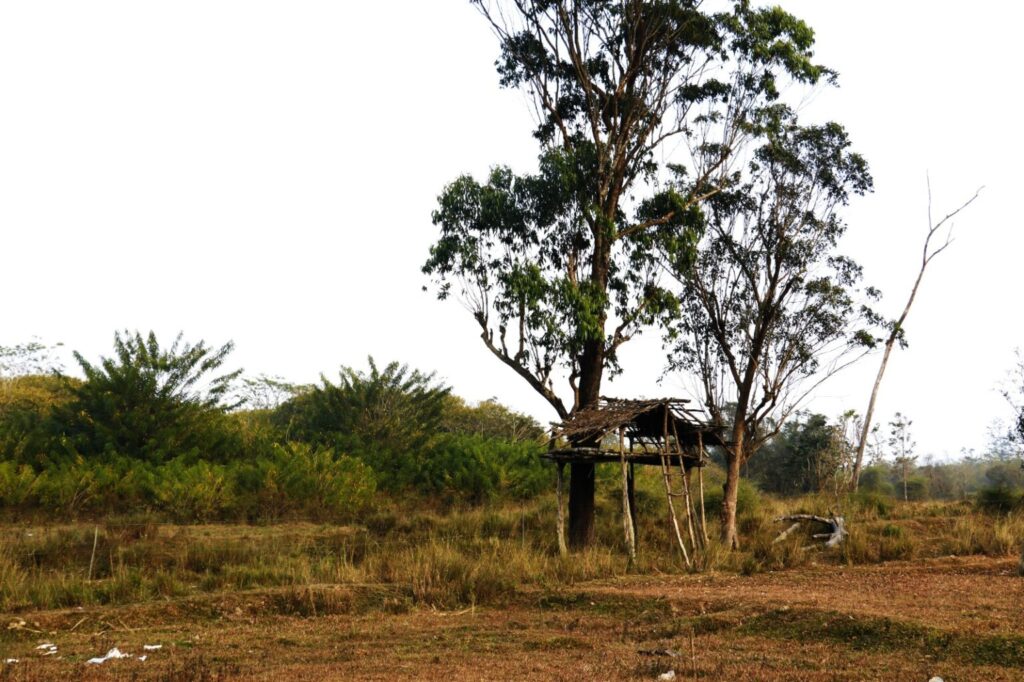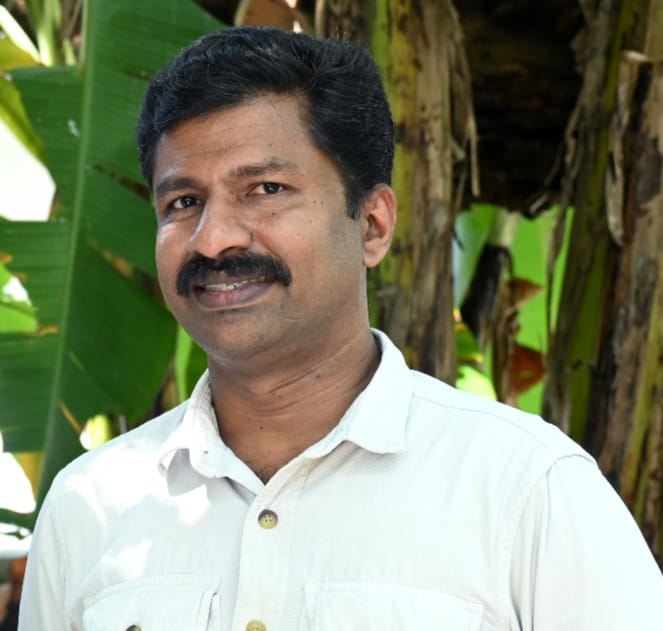
“We Entered Muthanga with Rice and Dreams, They Answered with Fire and Guns”
The protest at Muthanga was a struggle for the survival and dignity of the Adivasi people. Just as the government’s response was deeply flawed, so too were the interventions made by some groups in the name of environmental protection. The general public’s attitude towards Adivasi life was filled with prejudice, hostility, and apathy.
In the second part of this in-depth conversation, M. Geethanandan lays out the life the Adivasi communities dreamed of, the preparations they made for the Muthanga protest, and their efforts to build a new future.
Part II
Was the Aralam Farm, which was under the Agriculture Department and given for Adivasi resettlement, similarly handed over to other farms?
A small portion of land from Vithura Farm was given to Adivasis. The Nelliampathi Farm was taken over by the Tribal Mission. It was reserved forest land. All these lands come under the 30,000 acres identified by the Tribal Mission. The truth is that everyone opposed these projects, with the CPM leading the strongest opposition. Abdullah Kutty was the MP at that time. He met central ministers and told them not to give the Aralam Farm to the Adivasis. I have that letter in my possession. It stated clearly that the key land should not be given to the Adivasis. Workers who had left the farm were brought back and made to protest. They decided to blockade Janu. Since the farm was not operational, the workers were at home without any benefits. Goon squads were deployed to prevent Janu from entering the farm. They locked all the gates. Still, overcoming all that, we organised an Adivasi gathering at Aralam Farm before the Muthanga protest. The Adivasis insisted on performing a puja inside the farm and entered the premises. Janu arrived and transformed it into a long festival with a tribal puja that lasted for one and a half months. By March 2002, about a thousand Adivasis were inside the farm. Later, they were allowed to enter the Aralam Farm freely. The Tribal Mission also supported building huts there.
A protest took place in Aralam in November 2002 demanding land rights. The Muthanga protest happened in January 2003.
Was the fact that the chosen Muthanga protest site was a wildlife sanctuary considered? And was it expected to cause government opposition?
In truth, that was not considered. For us, all of Wayanad is essentially a wildlife sanctuary–covering about 35,000 square kilometers, including the Tholpetty, Sultan Bathery, Muthanga, and Kurichiyad ranges. Many Adivasi villages lie within these ranges. Therefore, it is incorrect to say that the protest at Muthanga was an encroachment into a wildlife sanctuary.
What happened at Muthanga was migration. People moved from surrounding settlements into the Muthanga range itself. Those coming from outside the Wayanad Wildlife Sanctuary were only from parts of Noolpuzha and Kottathara; the rest were from within various sanctuary ranges. People from Tholpetty, Thirunelli, Karamad, Gundikaparamba all lived inside the Tholpetty range. They came to Muthanga because they had no land there. Within the Muthanga range itself, eleven Adivasi colonies exist. So, it was never expected that the government would raise the political argument that the protest was an encroachment into a wildlife sanctuary.
When selecting the protest site, we considered only that it was not a forest with high biodiversity, even though the area was under the forest department. Moreover, a proposal to grant 30,000 acres of reserved forest land to the Adivasis was already before the central government. That was the leverage to take control of Muthanga.
Secondly, we believed that apart from the reserved forest, there was also vested forest land within Muthanga. The forest department itself didn’t have clear records of what exactly a reserved forest was. In their documents, it was just listed as “plantation.” The last official order declaring it a reserved forest was issued in 1942. Much of the rest was private forest land.
Roughly 8,000 acres of land were involved. And the truth is, all of it was fallow. The idea was to build a village there for about 5,000 people. We also considered the fact that the land was near the National Highway and not deep inside the forest. Around 4,200 Adivasis from 825 families had come to the area. There were three hills there: Ponkuzhi, Amboothimala, and Thakarappadi. The area had only planted bamboo, eucalyptus, and thorny shrubs. One could call it a “deemed forest”—not an actual forest, but land traditionally under the forest department.
From the Ponkuzhi temple area to the road leading towards Gudalur (called Njandirukki), the land had eucalyptus plantations planted for Birla. There was no biodiversity there.
As for wildlife presence—yes, that is true. But there’s a reason. Their water source is Noolpuzha, which lies on the other side of the main road. Since there’s no water in Muthanga, wild animals cross over to drink. That’s part of the issue. There is a cement pond in Muthanga, but there’s not a drop of water in it. Without greening the area, water won’t collect. It’s a sandy white-soil area. Even during the monsoon, the stream there runs dry. According to locals, until 40 years ago, Thakarappadi used to be marshland. It dried up after eucalyptus trees were planted. It wasn’t the Adivasis who destroyed the forest.

Can you describe the events related to entering Muthanga?
The Adivasis entered Muthanga on January 2nd and 3rd, 2003. Until the occupation began, the police had no idea what was happening, especially not the scale of it. As early as November 2002, while the Adivasi gathering was underway at Aralam, classes, activities, and preparations for a protest in Wayanad were already taking place across several hamlets. Lists of people who were willing to go were being drawn up. Landless people were ready to move anywhere for safety. It was only at the last minute that Muthanga was confirmed as the destination. Until then, everyone was simply told, “We’re going to a suitable location.” That’s all most people knew. A committee had been formed to finalise the site and other details.
The list included a thousand families from the Wayanad district. All meetings were held in public spaces. Nothing was secret. Those who were going were asked to contribute Rs 250 to buy plastic sheets for building sheds, and some money for food. Building materials were sourced from Mysore. Rice was stockpiled at different locations, like Theenoor Colony and some houses near Mananthavady. Around a thousand families had each organised 10 kilograms of rice.
A large group was asked to gather at Thiruvannur, a hamlet near Noolpuzha. People began arriving by evening. By night, around 500 families had reached there. From there, at 4 am, they crossed the fields through a colony called Pulithookki to reach Ambukuthy. People had gone to Pulithookki the night before. At 4 am, they walked for about ten minutes along a forest path and reached an open area near the forest. There were around a thousand people. By 6 am, they camped near a small stream beside a sacred grove close to Ambukuthy. People had carried their belongings in sacks from home. Many had even dismantled their old huts to move permanently to Muthanga. Some had brought livestock. Most had very little by way of personal possessions. But living permanently in Muthanga was their dream.
More people arrived during the day in vehicles. People from Janu’s native place came during the day. It was on the morning of January 3 that the local villagers realised something significant was unfolding at Muthanga. By the next day, the village officer and the tahsildar had started to arrive. Environmental activist Badusha was also there. It was George, the secretary of the cooperative society in the area and a CPM member, who informed the police, according to court records. They claimed it was a wildlife sanctuary and said entry was prohibited. There were some arguments between them and us. We said those matters had to be discussed with the government, not with us directly. We clarified we didn’t want to get into a dispute with them.
Each day, more people kept arriving. The police had not yet come to the site. They only showed up on the day the Muthanga incident took place. Forest department staff, however, visited regularly.
The first tents were set up on Ambukuthy hill. The next day, another group moved to Thakarappadi. In this way, people were spread out across different areas. After a week, sheds had been built in parts of all three hills. It resembled a village with shops, tea stalls, and sheds. During the day, people dug wells and built shelters. Later, groups were organised into “oorukoottams” (hamlet councils). Twenty-eight oorukoottams were formed, each named and assigned a traditional leader (mooppan).
Why did the police not intervene while all this was happening?
Forest officials came occasionally to ask some questions, but there were no other issues there. It was the time of the Global Investment Meeting (GIM). Later, it became clear that this was one reason the police stayed away. The information received was that after the meeting was over, serious action would be taken. By then, it would be February.
It was later understood that Muthanga was a place decided to be handed over to a private company for tourism as part of GIM. There were the Thenmala tourism and Muthanga tourism projects. Who was behind the project remains unknown even now.
After we entered Muthanga and stayed there for some days, a statement from Congress leaders also came out. They said development activities would not be allowed to be obstructed. They vowed to strongly support the Global Investment Project. The plan included a large helipad.
Also, environmental activists like Badusha from Wayanad were working alongside the forest department. They handled the Supreme Court case with the help of a contractor. They submitted a letter to the Central Empowered Committee (CEC) under the Supreme Court. This committee was supposed to review any transfer of forest land for non-forest purposes. Vivek Menon, a journalist, was the one who acted on behalf of Badusha. Vivek Menon wrote a letter to the Chief Minister demanding the eviction of the Adivasis. This letter was later cited as one reason to remove them.
However, the main issue was that Muthanga was a site set for sale. It was later learned that an industrial group from Kozhikode was involved. It was connected even to the newspaper Deepika.

Those who demanded the eviction of Adivasis from Muthanga in the name of conservation had other vested interests too, didn’t they?
What provoked Minister Sudhakaran may have been that a forest department project was obstructed. Besides, many of those who got involved had financial interests in the area. Badusha and his group operated on the fringes of that. Badusha’s younger brother even had a cattle farm inside the area. We came to know that their family had earlier links to mafia-like activities. Their income used to come from sandalwood smuggling and the timber trade. That’s how many people in Bathery made money in those days. At one time, Muthanga was part of the route used to smuggle sandalwood. Some of the labourers who had worked as porters for the smugglers told us about all this.
Also, the Muthanga checkpost was a hub for tax evasion. A permanent Adivasi presence in the area became a hindrance to many such shady operations. It was also a place where illicit liquor was brewed and poaching took place. Locals used to say that at least one deer would be taken out of there every day. Once we arrived, all that was disrupted. We declared the area a dry zone. We destroyed the brewing centres. We even formed a group of volunteers for this. That’s why we made enemies locally. Politicians and officials used these people against us. The crackdown on illicit liquor became the biggest problem.
Did these issues ever get reported in the media?
No, nobody explored these matters in depth. It became evident that Badusha was an agent of the forest department because of certain events. One was the helipad project—he was working with the forest department on it. They had also started building huts for tourists in the area. If he were truly an environmentalist, shouldn’t he have opposed such things?
Now the tax department’s checkpost is located beyond Thakarappadi. Earlier, it used to fall under the forest department’s jurisdiction. Before the Muthanga protest, the forest department had proposed to move the checkpost 2.5 kilometres away. Badusha and his group opposed it and successfully blocked the move. If the new checkpost came up, it would have shut down the routes used for smuggling. Only after the Muthanga agitation did the checkpost finally get relocated. Those who opposed it at the time claimed it would block elephant corridors. But that was just a front. It was the smuggling lobby’s demand. After the new checkpost was set up, several routes used for illegal trade were cut off.
Were there any major events between the time the Adivasis began living in Muthanga and the day of the police firing?
On January 15, a Northern Region meeting of the Forest Department took place in Palakkad. The Chief Forest Conservator attended it. That same day, he issued a press release which mentioned that action would be taken in Muthanga after February 15.
Another incident became a turning point in our protest, one that led directly to the police firing.
On February 17, a forest fire broke out. It was a deliberate act. Eucalyptus and other highly flammable trees made it the perfect time to set a fire. The calculation must have been that people would flee. I was in Thakarappadi. Janu had gone back to her village. Around 11 am, we spotted the fire. Ashokan, who later died, and I saw smoke coming from two kilometres east of Thakarappadi. Smoke was visible from two locations. We had earlier received word that some people had travelled eastward the previous day using a forest department road that had been closed to vehicles.
We realised the fire could quickly spread. If it reached Ambuthimala, the dry grass would catch fire and make things worse. Fires were already burning on both sides of Nellur Vayal. By the time we ran over, it was around noon. The previous day, a road had been cut between Ambuthimala and Thakarappadi. We worried that the people working there might get caught in the blaze. We moved them to a clear area near the road. By 1.30 pm, a large area had burned down. Around 20 huts were destroyed.
Around 2.30 pm, we came across some unfamiliar people–locals, forest department watchers, and others we had seen in multiple places. We stopped a hired vehicle and found petrol and dried elephant dung inside, along with the driver and two others. That’s when we figured out how the fire had started. We detained 22 people from different locations. Some of them later confessed. A photographer was also found on a scooter trailing the hired vehicle, likely to produce “evidence” framing us for starting the fire. We detained them and submitted a complaint to the Collector, saying our settlement had been deliberately set ablaze. The Collector came that night to investigate. But the next day, we were booked under a case for detaining 22 people, including three government officials.
On February 18, a hartal (strike) was called demanding the release of the detained individuals and the eviction of the Adivasis. Congress workers led the protest. Badusha’s men and CPM members joined in. The arrested individuals included people from various castes and the Muslim community. That was used against us to communally polarise the issue.
That same day, February 18, the police came to record our statements. They took the detainees back. They also told us who had ordered the fire. But in court, the official statement was that the fire had been caused during a counter-fire operation. That case is now in the CJM court in Ernakulam. The current accusation against us is that we illegally detained them. We demanded a CBI inquiry into the forest fire incident. Around 4,000 acres were burned. No investigation has been conducted so far. After the Muthanga incident, I submitted a request from jail demanding a probe into both the fire and the police firing.
The decision to evict us had already been made by February 18. On the night of February 17, around 8 pm, the Collector recorded our statement and left, accompanied by the SP and DySP. They said nothing could be done in the forest at night. On the way back, local crowds blocked the Collector and took away the papers he had in his hand to prevent him from adopting a position favourable to us. Gopalan, the Collector from Kollam, was truly frightened. He was forced to issue the eviction order. A law and order narrative had to be created. A Cabinet decision alone wouldn’t suffice. Everything was carefully planned. The groundwork began in Palakkad from February 15 onward.
After that, Minister Sudhakaran secretly came twice to Wayanad, as we learned. After we survived the forest fire, the police firing happened.
(to be continued)
Translated by Ebin Gheevarghese
